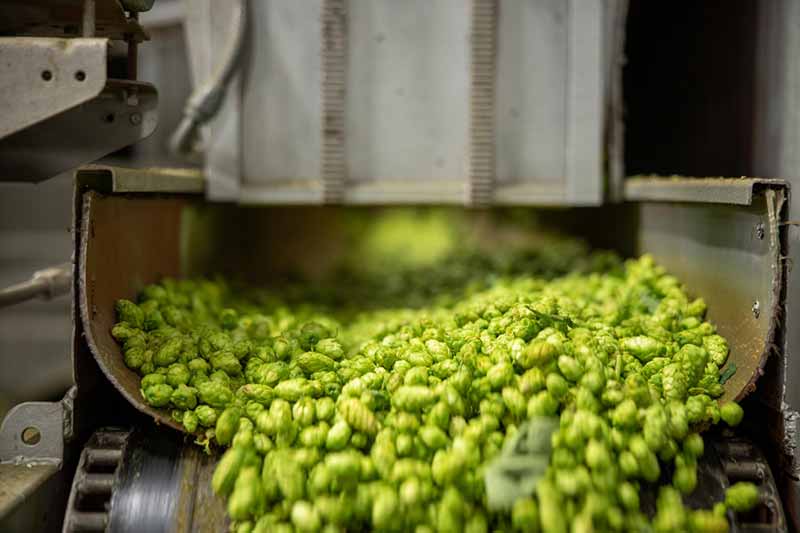
We’ve featured several heavy-hitter hops in this space. Whether classic ones like Centennial, uber-popular hops like Mosaic and Citra, up-and-coming hops like Nectaron and Galaxy, and even experimental hops like HBC 586 (now known as Krush) and, most recently, CLS-X14, the number of great options continues to grow. In the Pacific Northwest, Oregon-based Indie Hops has a hop that it believes could go toe to toe with any of the ones above: Strata.
We chatted with Indie Hops Co-Founder and Chief Executive Officer Jim Solberg as well as ISM Brewing Owner and Master Brewer Ian McCall, who has been using Strata since its initial release, to learn about the hop’s origin story, the characteristics that come through in a finished beer, and how to best use Strata in the brewing process.
(Above photography courtesy of Indie Hops)
Affordable, Industry-Leading Brewery Software
What Are the Ancestry and Analytics of Strata Hops?

Photography courtesy of Indie Hops
According to Solberg, Indie Hops started its hop breeding and R&D program in 2009, working with Oregon State to help feed new genetic material into the company’s hop development program. When things got rolling, Strata came about early.
“The first collection of seed in that program was on Perle hops, a female hop,” Solberg says. “That was open-pollinated, and so we don’t know right now which male was on the particular seed that produced Strata.”
Solberg says they are currently running tests and will determine the male within a year. He didn’t want to make any assumptions about the male hop.
“We just call it the guy who got there first,” Solberg says.
Strata, internally referred to as X331 before commercialization in 2018, came from the original seed gathering, which Solberg says was around 7,000 to 8,000 at the time.
Strata was the cream of that crop.
“We had a number of good ones but Strata was the top,” Solberg says. “We still have a couple of males used for breeding [from the initial run].”
Solberg notes that, unlike how the Hop Breeding Company or CLS Farms approach experimental hops, Indie Hops conducts the majority of its trials in-house. So when they were ready to go public with Strata, the timing limited its exposure.
“It’s interesting because, when you think about that, the 2018 harvest is for the 2019 brewing year,” Solberg says. “It had a year in the market before COVID hit, and everything quieted down.”
Solberg adds, “We’re now getting it out there more, and more brewers are using it, but there are still a lot of brewers that haven’t used Strata.”
The limited exposure didn’t prevent McCall from tracking down the hop in that first year of commercialization.
“It was at the Craft Brewers Conference in 2018 when I first learned of Strata,” McCall recalls. “I just left Beachwood Brewing and joined Riip [Beer Co.] and me and Riip Owner Ryan [Rasmussen] walked up to the Indie Hops booth and rubbed Strata, and I was taken aback.”
McCall says he was so blown away by the hop when they returned to Riip that he reached out to Indie Hops to get some for an upcoming collab beer. Indie Hops sent them one box of Strata.
“They were just starting to roll out their new marketing, and it was pretty limited [compared to] what was available,” McCall says. “Just getting the one box was a challenge.”
He adds, “We started fully contracting that next year.”
Strata averages about 13.5 percent alpha and 6 percent beta acids, with roughly 2.5 to 3.2mL of total oil per 100g dry hop material. But Solberg says the data isn’t the best way to know what you’ll get from the hop.
“We did a lot of the GC [gas chromatograph] testing in the early years, but it becomes more human sensory driven,” Solberg says. “You have to use that as the primary method of analyzing your hops.”
What Characteristics Emerge from Strata Hops?

Photography courtesy of Indie Hops
If not the data, what about the hop can we glean from its characteristics? McCall says his first impression caused a sensory overload.
“It was dank but super punchy,” McCall says. “It reminded me along the lines of a good lot of Mosaic.”
McCall adds, “It is semi-tropical but with fruity notes, and also dank. It’s a punch in the face.”
When McCall brewed with Strata, he says a few things came to the forefront.
“It’s a fruit bomb,” McCall says, who still loves Strata even a half-decade later. “So many of us West Coast IPA brewers are looking for fruity top-end notes. With Strata, I get a lot of pineapple and tropical ripe fruit. But it’s multidimensional and has nice foundational dankness.”
He adds, “It tastes like a bunch of hops in one. That’s why I absolutely love this hop.”
Solberg says that the name Strata came from the notion of having greater than average layering —layers of character. That tracks with McCall’s belief that it tastes like many hops rolled into one.
“For us, the main descriptors that come up over and over are passionfruit, strawberry, and Ruby Red grapefruit,” Solberg says. “Some annual users of a lot of Strata will have descriptors outside of that, but those are most common.”
Solberg adds that, beyond the fruit, Strata delivers a “wafting cannabis” aroma.
“A brewer came by [to select hops one time] and called it ‘rock concert cannabis,’” Solberg says. “It’s got that sweet sticky rhubarb cannabis aroma from around the corner. It’s an aroma that ties the fruit together really nicely.”
Solberg adds, beyond what it brings to beer, Strata has agronomical benefits.
“It has natural disease resistance, vigor, consistency across weather and soil types,” he says. “Year in and year out, the growers are super excited because they use very little pesticide, fungicide, and chemicals and save money.”
He adds, “It’s easier on the environment, stays healthy, and you’re more likely to get great options [no matter the lot].”
Can Strata Hops Dominate a Beer?

Photography courtesy of Strata Hops
Solberg thinks so.
“It’s definitely the driver of the show,” he says. “There aren’t many hops that can do that, but you can completely fill out the hops with Strata. It has everything.”
Solberg says that, more often than not, if you try to bring another hop into the mix, it just doesn’t make the beer better.
“[Strata] is a tremendous single-hop IPA hop,” Solberg says, “layering it out through the different parts of the brew process.”
McCall thinks Strata is great whichever way you slice it.
“It lifts all other hops,” McCall says. “It’s a great foundational player but does stand alone.”
And that’s across-the-board greatness. McCall says they’ve used T-90 Strata hops, CGX Strata, and fresh hops, which Indie Hops picked at 4 a.m. and he threw into the kettle by 2 p.m.
“Every time, without fail, this hop stands out,” McCall says. “It’s a great single-hop varietal.”
When Should You Use Strata Hops?

Photography courtesy of ISM Brewing
McCall says he’s a fan of first-wort hopping with Strata. He says he opts to use a lot of high-flavor hops like Strata during the first wort charge.
He does say there is a spot to avoid.
“I definitely wouldn’t use it for bittering,” McCall says. “Why waste a dynamic hop?”
As Solberg noted above, Strata is nice to use throughout brewing.
“I think it’s got a lot of layers that work well together,” he says.
“It works well as you get through the latter part of the boil, after the boil, then in the dry hop— whether fermentation is still taking place or after.”
However, Solberg notes that Strata can deliver different results based on the lot.
“Generally speaking, lay it on the hot side, and you’ll see the passionfruit, strawberry, fruity side,” he says. “Post-fermentation and dry hop, you’ll get the Ruby Red grapefruit and wafting cannabis component.”
McCall also goes for big whirlpool, active fermentation, and post-fermentation hop additions with Strata.
“It showcases what it can do,” he says.
Which Style of Beer Works Best for Strata Hops?

Photography courtesy of ISM Brewing
Despite seeing Strata mostly in single or double IPAs, Solberg says that he thinks it is a multi-purpose hop.
“The nice thing about it is it’s a clean and punchy hop,” he says. “You can bring it into a lower-ABV hoppy pale.”
What about even lower ABV and lighter beers?
“We personally discourage folks from using higher resin in a traditional lager, but you could certainly take it into a West Coast pils,” Solberg says. “Because it’s a very clean hop that doesn’t have the baggage of other high-alpha hops.”
McCall says the first beer they made with Strata was a low-ABV IPA, around 5.5% ABV. In that, they used equal parts Strata and Mosaic. The latest beer he’s working on at ISM is a wet-hop IPA with Strata and Ekuanot called Swell Cutter.
“It has big bright pineapple, underlying cannabis dankness,” McCall says, “and it was a gem.”
He strongly feels that Strata is best utilized in an IPA.
“I’m a West Coast IPA producer at heart. That’s my love of beer,” McCall says. “Many will utilize it in hazies, but I think it shows best in the West Coast.”



